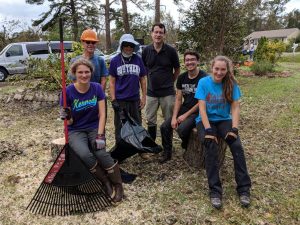Intervene with Individuals, Families, Groups, Organizations, and Communities
Practice Behaviors:
8.1 – Critically choose and implement interventions to achieve practice goals and enhance capacities of clients and constituencies
8.2 – Apply knowledge of human behavior and the social environment, person-in-environment, and other multidisciplinary theoretical frameworks in interventions with clients and constituencies
8.3 – Use inter-professional collaboration as appropriate to achieve beneficial practice outcomes
8.4 – Negotiate, mediate, and advocate with and on behalf of diverse clients and constituencies
8.5 – Facilitate effective transitions and endings that advance mutually agreed-on goals
One of the main goals of the social work profession is to help clients during the intervention stage. Depending on the area of social work, the intervention can be a fast, short-term fix (disaster response), or a longer process (addiction therapy). However, the goal is to implement a change with the client to help them achieve the mutually-agreed on goals that they have. This is where my skills from my classes have assisted me in helping clients find the correct intervention plan that works best for them. As I continue to work within social work, I strive to create the appropriate intervention plans that suit my clients.
Evidence 1 (Class): During my Social Work Practice with Individuals (SOCW-309) class, I was able to conduct a 30-minute interview with a pseudo-client. The interview needed to go through as much of the GIM model as possible. My client was a victim of abuse who had two small children. She sought help because she was not sure what she could do and was scared for her and her children’s safety. During the interview, I was able to create an action plan for the client to have in case she needed to utilize it. We discuss several short-term options that she had in the area as well as long-term goals if she were to leave the relationship. The two intervention plans that we created we designed for the client to assist her in escaping the violence of her relationship. To view this video, please click here.
Evidence 2 (Field): When clients first arrive in the United States, they go through several orientations and in-take meetings to help them learn more about the program and what they should expect. In the intake meeting, an action plan is created with the client. This form records the client’s experience and their short-and-long-term goals for the future. I was able to work with a client to complete their action plan. During the meeting, the client expressed that within five years they wanted to open their cafe where they would be able to serve Sudanese coffee and food. To view a copy of the action plan here. To see my journal entry, please click here and see week 2.

The team from Southern Adventist University (helping with debris removal and muck outs)
Evidence 3 (Additional): During my time down in North Carolina, I was given the opportunity to help intervene with clients directly. The trip was dedicated to assisting families and neighborhoods that had been affected by Hurricane Florence. We helped to clear debris from people’s properties and for one family, we helped to take out the carpet and other ruined furniture. Our intervention was very hands-on since much of what we did was make sure to clean up fallen trees and other trash items for the Federal Emergency Management Agency (FEMA) to collect. We chose the correct interventions needed for each family after assessing the property. For some, we would cut up fallen trees, while other places we helped to clean up broken furniture. To read more about this trip, please click here.
Skills Used: One of the main skills that I used was that of interpersonal relationships and group facilitation. I was able to connect well with people while also addressing the needs of the client(s).
Knowledge Used: Based on my Social Work Practice with Families and Groups (SOCW-321) class, I learned how to efficiently facilitate a small group in leading the conversation. I also used information from Interviewing Skills (SOCW-213) to be able to interact with clients and learn what issues were present and create an intervention strategy for them.
Values Presented: The dignity and worth of an individual is a value that can be seen used in this competency. Before creating and implementing an intervention strategy, it is important to give the client the right to self-determination and respect the client as part of the intervention process.
Cognitive Processes Used: After analyzing the information presented from clients, I was able to propose an intervention that best suited the situation. I was able to demonstrate the ability to comprehend the needs of the client and create a solution that the client wanted.
Affective Processes Used: During the psychoeducational group, I needed to cooperate with both my co-leader and the group members. By being able to work well with both parties, helped the group run smoothly. I was also able to create and implement different plans to assist clients in achieving their goals and expectations.
Theoretical Foundation: A theory that works well with intervention is the Strategic Contingencies Theory. The theory focuses on the aspect of being competent which therefore makes you more powerful since you are in high demand. As it relates to competency 8, social workers are in high demand due to their skills in being able to adequately create the appropriate interventions as needed. For me, by learning the specified skill set of social work and how to properly intervene with people, I will become more necessary for those who have issues that a social worker is prepared for.
